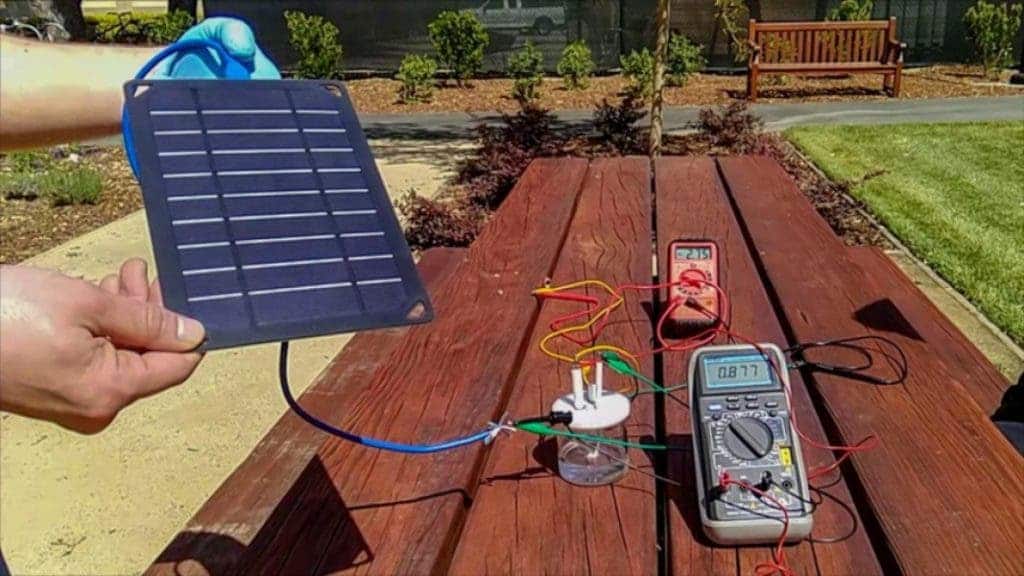Researchers from Stanford University have developed a process to make hydrogen fuel using only electrodes, solar power, and saltwater from the San Francisco Bay.

Image credits Yun Kuang et al., (2019), PNAS.
Hydrogen fuel holds a lot of promise as the energy source of the future. It’s clean, doesn’t emit anything, it’s energy-dense, and it’s beyond abundant — if only we were able to develop a way of retrieving the element from its chemical constraints. A new paper describes a way to do just that, starting from saltwater.
Salt of the water
Why is this news? Well, it simply comes down to quantities — the Earth has a lot of saltwater, but not very much fresh water. Methods of producing hydrogen fuel from the latter have already been developed, but the fact of the matter is that fresh water is valuable. We need it to drink, we need it to wash, we need it to grow our crops and, as our planet’s population increases, we run a very real risk of not having enough water for everyone. So it doesn’t make sense to use it for energy — we need it elsewhere.
“You need so much hydrogen [to power our cities and economies that] it is not conceivable to use purified water,” said Hongjie Dai, J.G. Jackson and C.J. Wood professor in chemistry at Stanford and co-senior author on the paper. “We barely have enough water for our current needs in California.”
Salty water, in contrast, is plentiful — which also means cheap. There’s enough of it that we can turn it into hydrogen without upsetting the natural balance of Earth’s ecosystems too much. Hydrogen fuel also doesn’t emit carbon dioxide as it ‘burns’, only water. Given our current troubles with man-made climate change and habitat destruction, both are very appealing qualities.
Saltwater does, however, come with a major drawback. It’s not that hard to split water into hydrogen and oxygen, and we’ve known how to do it for a long time now. Just take a power source, connect two wires to and place their other end (or some electrodes if you want to be fancy about it) in water. Turn the power on, and you’ll get hydrogen bubbles at the negative end (cathode), and oxygen bubbles at the positive end (anode). This process is called electrolysis.
So far so good. But, if you try the same thing with saltwater, the chloride ions in salt (salt is a mix of chloride and sodium atoms) will corrode the anode and break down the system pretty quickly. Dai and his team wanted to find a way to stop those components from breaking down in the process.
Their approach was to coat the anode in several layers of negatively-charged material, which would repeal chloride, thus prolonging the useable life of the electrolysis rig. They layered nickel-iron hydroxide on top of nickel sulfide, over a nickel foam core. The nickel foam acts as a conductor, carrying electricity from the power source, while the nickel-iron hydroxide performs the electrolysis proper, separating water into oxygen and hydrogen.
As this happens, the nickel sulfide becomes negatively charged, protecting the anode. Just as the negative ends of two magnets push against one another, the negatively charged layer repels chloride and prevents it from reaching the core metal. Without the coating, the anode only works for around 12 hours in seawater, according to Michael Kenney, a graduate student in the Dai lab and co-lead author on the paper.
“The whole electrode falls apart into a crumble,” Kenney said. “But with this layer, it is able to go more than a thousand hours.”
Another bonus this coating brings to the table is that it allows for electrolysis to be performed at much higher currents. Previous efforts to split seawater had to use low current, as higher values promote corrosion. The team was able to conduct up to 10 times more electricity through their multi-layer device, which helps it generate hydrogen faster. Dai says they likely “set a record on the current to split seawater.” By eliminating the corrosive effect of salt, the team was able to use the same currents as those in devices that use purified water.
The team conducted most of their tests in controlled laboratory conditions, where they could regulate the amount of electricity entering the system. But, they also designed a solar-powered demonstration machine that produced hydrogen and oxygen gas from seawater collected from San Francisco Bay. Dai says the team pointed the way forward but will leave it up to manufacturers to scale and mass produce the design.
“One could just use these elements in existing electrolyzer systems and that could be pretty quick,” he adds. “It’s not like starting from zero — it’s more like starting from 80 or 90 percent.”
In the future, the technology could be used to generate breathable oxygen for divers or submarines while also providing power. And, perhaps, it could also be used in space exploration to limit the need for water purification systems — at least as far as power and oxygen are concerned.
The paper ” Solar-driven, highly sustained splitting of seawater into hydrogen and oxygen fuels” has been published in the journal Proceedings of the National Academy of Sciences.






